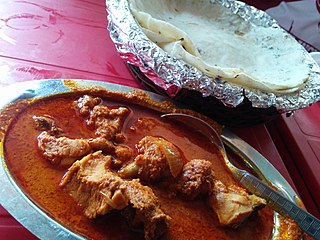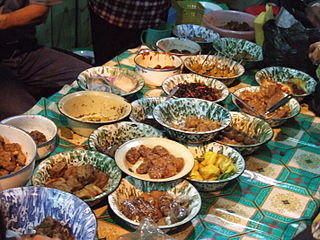
Tripe is a type of edible lining from the stomachs of various farm animals. Most tripe is from cattle, pigs and sheep.

Pares, also known as beef pares, is a term for a serving of Filipino braised beef stew with garlic fried rice, and a bowl of clear soup. It is a popular food particularly associated with specialty roadside diner-style establishments known as Pares Houses that specialize in serving these type of meals. In recent years, it had also become a common dish served in small eateries called karinderya or carinderia that serve economical meals for local residents.

Trinidad and Tobago has a unique history and its food is influenced by Indian-South Asian, West African, Creole, European, American, Chinese, Amerindian, and Latin American culinary styles. Trinidadian and Tobagonian food is dominated by a wide selection of dishes, most notably, doubles, pelau, callaloo and curried crab and dumplings. Trinidad and Tobago is also known for its prepared provisions, such as dasheen, sweet potato, eddoes, cassava, yam, soups and stews, also known as blue food across the country. Corresponding to the Blue Food Day event held annually in Trinidad and Tobago.

Pyttipanna (Swedish), pyttipanne (Norwegian), pyttipannu (Finnish) or biksemad (Danish), is a culinary dish consisting of chopped meat, potatoes and onions fried in a pan, similar to a hash, and popular in Scandinavia. The term is Swedish for "small pieces in pan".

Peasant foods are dishes eaten by peasants, made from accessible and inexpensive ingredients.

Pabellón criollo is a traditional Venezuelan dish, the local version of the rice and beans combination found throughout the Caribbean. It is a plate of rice, shredded beef in stew and stewed black beans.

Singaporean cuisine is derived from several ethnic groups in Singapore and has developed through centuries of political, economic, and social changes in the cosmopolitan city-state.
Soup beans is a term common in the Southern United States, particularly the regions around the Appalachian Mountains. Soup beans are usually served with cornbread, greens, and potatoes and may be topped with raw chopped onions or ramps. Soup beans are considered a main course, but also serve as a side dish. In rural areas, where food was scarce during the winter, these dried beans were a staple food.

Liaoning cuisine is derived from the native cooking styles of the Liaoning Province in China. It is the most famous Northeastern Chinese cuisine.
The tendons of certain animals are used as an ingredient in some Asian cuisines, including the Filipino, Chinese, Japanese, Korean, Indonesian, Thai, Laotian, Cambodian and Vietnamese traditions. Tendon is tough and fibrous, but becomes soft after a long period of cooking. In some cases it may be boiled for as long as eight hours, while in other dishes it is prepared by deep frying. It contains large amounts of collagen, and after boiling or stewing, it is sometimes described as mimicking the mouthfeel of high-fat cuts of beef despite its low fat content. One author described the taste of deep-fried tendon as being similar to chicharrón.

Chicken curry is a dish originating from the Indian subcontinent. It is common in the Indian subcontinent, Southeast Asia, Great Britain, Caribbean, and Japan. A typical curry from the Indian subcontinent consists of chicken stewed in an onion- and tomato-based sauce, flavoured with ginger, garlic, tomato puree, chilli peppers and a variety of spices, often including turmeric, cumin, coriander, cinnamon, and cardamom. Outside of South Asia, chicken curry is often made with a pre-made spice mixture known as curry powder.

Fried plantain is a dish cooked wherever plantains grow, from West Africa to East Africa as well as Central America, the tropical region of northern South America and the Caribbean countries like Haiti to Cuba and in many parts of Southeast Asia and Oceania, where fried snacks are widely popular. In Indonesia it is called gorengan. It is called alloco in Côte d'Ivoire and dodo in Western Nigeria, otherwise known as simply fried plantain in other parts of Nigeria. Kelewele is a fried spicy plantain or can be fried as a side dish for Red Red and fish stew in Ghana.

Squid is eaten in many cuisines; in English, the culinary name calamari is often used for squid dishes. There are many ways to prepare and cook squid. Fried squid is common in the Mediterranean. In New Zealand, Australia, the United States, Canada, and South Africa, it is sold in fish and chip shops, and steakhouses. In Britain, it can be found in Mediterranean 'calamari' or Asian 'salt and pepper fried squid' forms in various establishments, often served as a bar snack, street food, or starter.
Dominica cuisine is the cuisine of the island nation of Dominica. The cuisine is rooted in creole techniques with local produce flavored by spices found on the island. Dominican cuisine is a mixture of indigenous Kalinago, African, French, and English influences.

A croquette is a deep-fried roll originating in French cuisine, consisting of a thick binder combined with a filling, which is then breaded. It is served as a side dish, a snack, or fast food worldwide.

Nasi jamblang is a typical food of Cirebon, West Java. The "jamblang" term comes from the name of the region to the west of the city of Cirebon, where food vendors first sold the dish. A characteristic feature of the dish is the usage of teak leaves to pack the rice. The dish is served buffet-style.

Nasi padang, sometimes referred to as Padang rice, is a Minangkabau dish of steamed rice served with various choices of pre-cooked dishes originating from West Sumatra, Indonesia. It is named after the city of Padang, capital of the West Sumatra province. A miniature banquet of meats, fish, vegetables, and spicy sambals eaten with plain white rice, it is Sumatra's most famous export and the Minangkabau people's primary contribution to Indonesian cuisine.

Quesabirria is a Mexican dish comprising birria-style cooked beef folded into a tortilla with melted cheese and served with a side of broth for dipping. The dish, which has origins in Tijuana, Mexico, originally made with goat meat, gained popularity in the United States through Instagram. It is now made also with other meats, such as beef and chicken.















